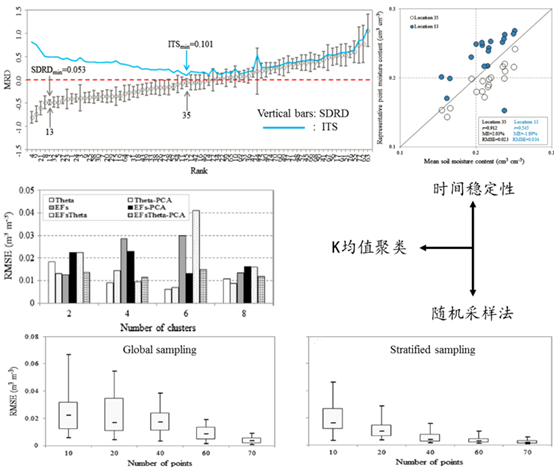Soil moisture is an important variable influencing water, solute and energy fluxes in the earth surface. The most important step after obtaining satellite-based soil moisture estimates is to validate them against the observed values. This needs to upscale point-scale soil moisture measurements to satellite-scale pixel averages.However, direct measurement of soil moisture content at the satellite resolution is costly, time-consuming and labor-intensive. In this case, the representative sampling sites are needed to be identified for accurate prediction of mean soil moisture content in a certain area and ground-based soil moisture measurements in catchment or hillslope hydrological studies.
Recently, Zhu Qing research team evaluated three approaches (temporal stability, K-means clustering, random sampling) for identifying optimal sites to predict mean hillslope soil moisture content. Results showed that the temporal stability (TS) based on the smallest index of temporal stability (ITS) was better (RMSE = 0.023 m3 m−3) than that based on the smallest standard deviation of relative difference (SDRD) (RMSE = 0.034 m3 m−3). The K-means clustering based on EFs Theta (-PCA) was better (RMSE <0.020 m3 m−3) than these based on EFs (-PCA) and Theta (-PCA). The sampling design stratified by the land use was more efficient than the global random method. Forty and 60 sampling sites are needed for stratified sampling and global sampling respectively to make their performances comparable to the best K-means method (EFsTheta-PCA). Overall, TS required only one site, but its accuracy was limited. The best K-means method required <8 sites and yielded high accuracy, but extra soil and terrain information is necessary when using this method. The stratified sampling strategy can only be used if no pre-knowledge about soil moisture variation is available. This information will help in selecting the optimal methods for estimation the area mean soil moisture. The results were recently published in the Journal of Hydrology(TOP,IF=3.043),first author is the assistant researcher Liao Kaihua.

Error analysis of different approaches for identifying optimal sites to predict mean hillslope soil moisture content
Paper link: http://www.sciencedirect.com/science/article/pii/S0022169417300525
(Information source: Nanjing Branch of CAS)

